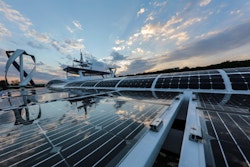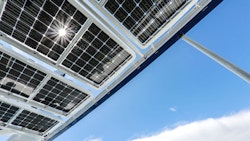Solar energy, the crew’s number one ally
Solar energy is the primary source of energy production aboard the Energy Observer. The team enjoyed optimal sunshine whilst navigating in the Mediterranean where they fully exploited the potential of the photovoltaic panels covering the hulls, nacelle and wings of the craft.
A total 141 m2 of cells are connected with 6.2 km of Prysmian cables, used in the aerospace industry for optimal weight reduction. Two different solar panel technologies are used to optimise surface coverage: conformable panels and bifacial panels.
Conformable photovoltaic panels
These flexible panels snugly fit over the curved shape of the central nacelle. Traditional rigid panels would not have covered nearly as much of this area. The panels are made with Sunpower cells, amongst the most productive in the world, and Solbian encapsulation material, both hard-wearing and lightweight. Standard panels for use on land weigh up to 20 kg for 300 W. The panels on the Energy Observer weigh 4 kg for 300 W, dividing the weight by five.
Some of the panels, such as on the hulls, have a non-slip coating so the crew can move about safely. Apparently, this finish boosts yield, as they produce more energy than uncoated panels when the sun is low.

Energy Observer's Solar Panels
Bifacial photovoltaic panels
Mounted on the side and aft wings, and on the glass roof of the central nacelle, the bifacial panels provide daylight to the crew while continuing to produce energy. They were specially developed by the French Institut National de l’Energie Solaire in Chambéry. As the name suggests, they collect sun rays from both above and below thanks to the reflection of light on the white surfaces of the craft and on the sea. Another advantage: the encapsulated cells made from thin polycarbonate are flexible and light. Also, natural air circulation cools them, boosting their output… As a result, they produce 30% more energy than traditional single-sided panels.
Where only one type of silicon is usually used in standard solar panels, the bifacial panels on the Energy Observer contain two types of silicon, due to “heterojunction” This configuration converts solar energy into electricity more efficiently, providing 22% output. Most panels on the market level out at 19%. Finally, all the cells are independently connected to each other so that the panel continues to operate if one of them breaks. That’s why there’s so much cable… and why a product used in the aerospace industry was selected to reduce weight!

Energy Observer's Solar Panels
A very positive solar energy balance
The solar energy production results are very positive: 40% of the energy provided by the 141 m2 of photovoltaic panels powered the batteries during the day while navigating. The rest came from hydrogen produced during stopovers. Production peaked at a maximum of 23.7 kWc. In the Mediterranean, average solar production fluctuated between 100 and 120 kWh per day. The sailors and engineers estimate that the impact of less sunshine in Northern Europe would reduce production to a maximum 60 to 70 kWh per day with the current equipment.
That’s why the photovoltaic panel surface of Energy Observer will be increased by 27 m2 to reach a total surface area of 168 m2 for maximum production of 28.5 kWc. Even if there is less sunshine in the future, there is nothing to fear from the cold, which is very good for improving panel yield.